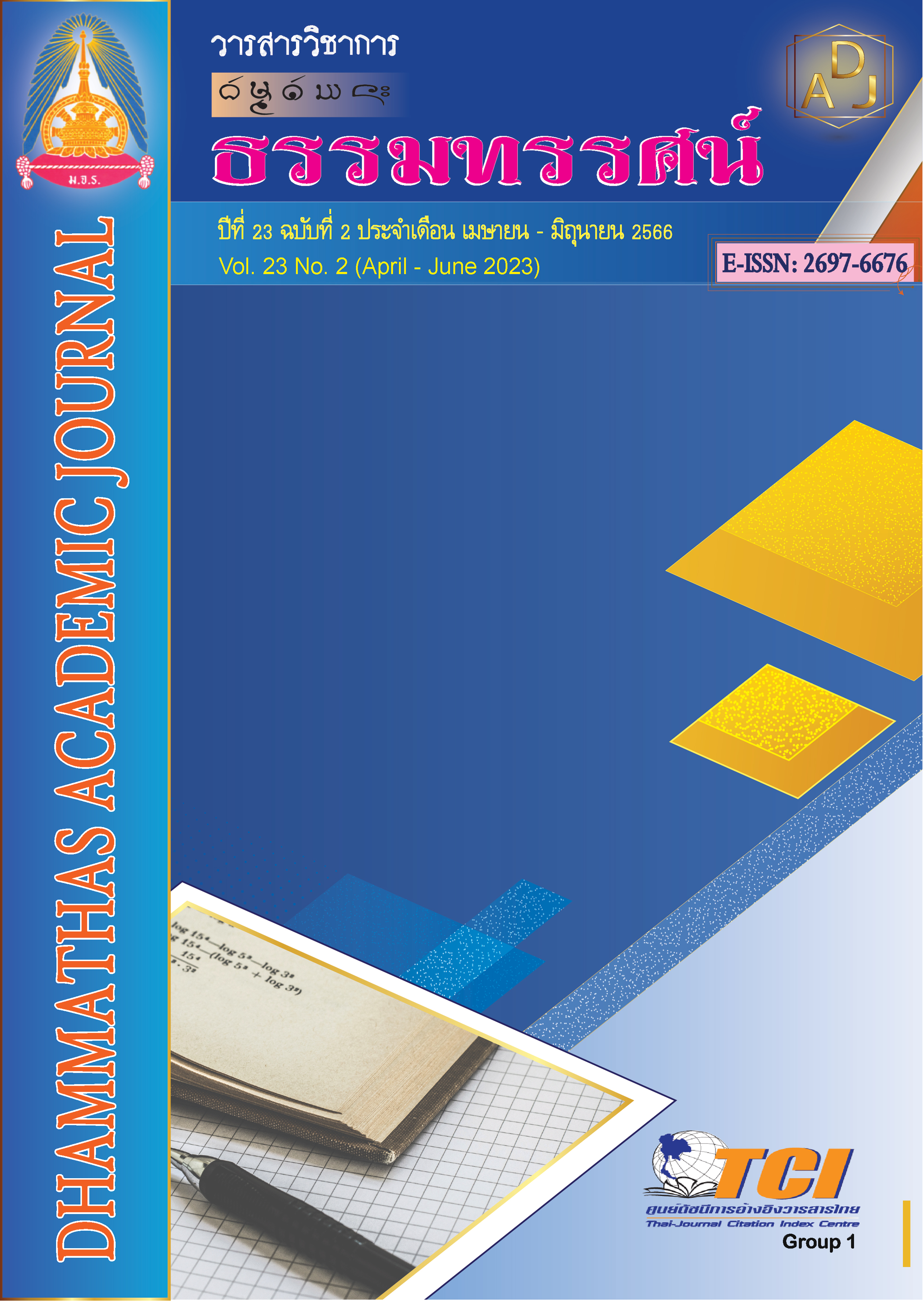Analysis of the essence of Mangalatthatipani according to Ashram 4
Main Article Content
Abstract
The objectives of this research were; 1) to study the essence of Ashram 4, 2) to study the essence of Mangaladipani, 3) to analyze the essence of Ashram 4 as documentary research. Collected from primary and secondary documents, analyzed by a descriptive method based on the inductive method.
The research results were as follows:
1. Ashram is a practice in each stage of Brahmanism; consisting of 1) Brahmin 2) Lahustha 3) Vanaprasth 4) Sanyasi is a way of life that people in Indian society follow in each stage of life. This practice must be strictly adhered to by the Brahmin caste in every ashram. Those in the Royal caste and Vaishya caste will adhere to only the first two ashrams (Bharat, Laymen) only.
2. Mangaladipani It is a Pali scripture in the Pali language that Phra Sirimangalajarn wrote in the year 886 AD. (BC. 2097) to describe the Mangala Sutta in the Khuddaka Pātha, Sutta Nipāta, Sutta Piṭaka. There are references to the content from the commentary, Supreme Court, and Jataka tales are quoted as an explanation. There are 11 spells with 38 auspicious contents that are used as guidelines for improving the quality of life.
3. Synthesis according to the fourth ashram framework can be done as follows: 1) the 1st-11th auspiciousness of entering the virgin ashram, i.e. not associating with bullies - nurturing mothers and fathers because it is an early age in life, must learn the theory correctly. There are 94 Jataka tales. 2) Synthesis of the 12th-23th auspicious things into the layman’s ashram, namely child support-humility. There are 43 Jataka tales. 3) Synthesis of 24th - 30th auspicious things into the Ashram of Vanaprasat, i.e. solitude - Discussing the Dharma according to the times. There were 42 Jataka tales and 4) Synthesis of the 31-38 auspicious things into the Sanyasi Ashram, namely asceticism-cittakasem and 38 auspicious items.
Article Details

This work is licensed under a Creative Commons Attribution-NonCommercial-NoDerivatives 4.0 International License.
เพื่อให้เป็นไปตามกฎหมายลิขสิทธิ์ ผู้นิพนธ์ทุกท่านต้องลงลายมือชื่อในแบบฟอร์มใบมอบลิขสิทธิ์บทความ ให้แก่วารสารฯ พร้อมกับบทความต้นฉบับที่ได้แก้ไขครั้งสุดท้าย นอกจากนี้ ผู้นิพนธ์ทุกท่านต้องยืนยันว่าบทความ ต้นฉบับที่ส่งมาตีพิมพ์นั้น ได้ส่งมาตีพิมพ์เฉพาะในวารสาร วิชาการธรรม ทรรศน์ เพียงแห่งเดียวเท่านั้น หากมีการใช้ ภาพหรือตารางของผู้นิพนธ์อื่นที่ปรากฏในสิ่งตีพิมพ์อื่นมาแล้ว ผู้นิพนธ์ต้องขออนุญาตเจ้าของลิขสิทธิ์ก่อน พร้อมทั้ง แสดงหนังสือที่ได้รับการยินยอมต่อบรรณาธิการ ก่อนที่บทความจะได้รับการตีพิมพ์References
บุญมี แท่นแก้ว. (2548). ปรัชญาศาสนา. (พิมพ์ครั้งที่ 2). กรุงเทพฯ: โอเดียนสโตร์.
บุปผา กาหลง. (2552). มงคลสูตรกับการสร้างสิ่งแวดล้อมทางสังคม. (วิทยานิพนธ์ศิลปศาสตรมหาบัณฑิต). สมุทรปราการ: มหาวิทยาลัยราชภัฎธนบุรี.
ปิ่น มุทุกันต์. (2555). มงคลชีวิต. (พิมพ์ครั้งที่ 7). กรุงเทพฯ: สร้างสรรค์บุ๊คส์.
พระครูสิริสุตานุยุต. (2556). ศึกษาพัฒนาการมงคลสูตรในพระพุทธศาสนา. (สารนิพนธ์พุทธศาสตรดุษฎีบัณฑิต). พระนครศรีอยุธยา: มหาวิทยาลัยมหาจุฬาลงกรณราชวิทยาลัย.
พระบุญชู กัลณา. (2551). การวิเคราะห์การศึกษาตามหลักไตรสิกขาในพระพุทธศาสนาเถรวาท. (วิทยานิพนธ์ศิลปศาสตรมหาบัณฑิต). เชียงใหม่: มหาวิทยาลัยเชียงใหม่.
พระมหานิกร สุวรรณดี. (2544). การศึกษาวิเคราะห์หลักความเชื่อเรื่องระบบวรรณะชาวฮินดูในประเทศไทย. (วิทยานิพนธ์อักษรศาสตรมหาบัณฑิต). นครปฐม: มหาวิทยาลัยมหิดล.
พระมหาสม สุมโน. (2537). ศึกษาเปรียบเทียบทรรศนะคุณค่าชีวิตของมนุษย์ในลัทธิฮินดูและในพุทธศาสนา. กรุงเทพฯ: นีลนารา.
พระมหาสมชาย ฐานวุฑโฒ. (2557). มงคลชีวิต ฉบับทางก้าวหน้า. กรุงเทพฯ: รุ่งศิลป์การ.
พระราชวรมุนี (ประยุทธ์ ปยุตฺโต). (2528). รากฐานพุทธจริยศาสตร์ทางสังคมเพื่อสังคมไทยร่วมสมัย. กรุงเทพฯ: เทียนวรรณ.
พระอธิการก้าน ตกุสโล (พุ่มสละ). (2556). การศึกษาวิเคราะห์ระบบวรรณะสี่ตามทัศนะพระพุทธศาสนาเถรวาท. (วิทยานิพนธ์พุทธศาสตรมหาบัณฑิต). พระนครศรีอยุธยา: มหาวิทยาลัยมหาจุฬาลงกรณราชวิทยาลัย.
มหาจุฬาลงกรณราชวิทยาลัย. (2539). พระไตรปิฎกภาษาไทย ฉบับมหาจุฬาลงกรณราชวิทยาลัย. กรุงเทพฯ: มหาจุฬาลงกรณราชวิทยาลัย.
มหาวิทยาลัยมหาจุฬาลงกรณราชวิทยาลัย. (2545). มังคลัตถทีปนี ภาษาไทย ภาค 1. กรุงเทพฯ: มหาจุฬาลงกรณราชวิทยาลัย.
วศิน อินทสระ. (2549). พุทธจริยศาสตร์. (พิมพ์ครั้งที่ 2). กรุงเทพฯ: ธรรมดา.
สุมาลี มหณรงค์ชัย. (2546). ฮินดู-พุทธ จุดยืนที่แตกต่าง. กรุงเทพฯ: สุขภาพใจ.

